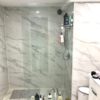How to install shower rail. Prolific Plumbing in Oatley, Sydney is happy to install a shower rail and will tell you how to do it. Before you start to install a shower rail, it’s important to understand the type of shower rail that will satisfy your needs. We need to explain what shower rail are, the benefits of installing a shower rail, and a step-by-step guide on how to install a shower rail.
What is a shower rail?
Shower rail kits are one of the most well-known forms of shower outlet in the bathroom. They are made up of a showerhead, a shower hose, and a rail on which the shower heads slide up and down which brings us to the part where we define what a shower rail is.
Slide rail showers are a bit more meticulous but more docile than a fixed shower head, so perfect for people that don’t want to wash their hair every time they take a shower. A shower rail kit allows you to quickly adjust the height of the showerhead for optimum comfort so that tall people won’t have to always bend over and shorter individuals can bring the shower head closer to them.
The slider rail usually travels vertically up the wall and has two stoppers positioned at each edge. The showerhead that is attached to the taps through a hose then slides up and down this rail depending on the length you pick.
Shower riser rails are obtainable in different types and styles of designs, including the curved adjustable shower curtain rods, adjustable straight shower curtain rods, fixed single curved shower curtain rods, tension double curved shower curtain rod, and fixed single straight shower curtain rod. We are going deeper into the types of shower rails.
Types of shower rails
There are some qualities we need to consider when we are buying and installing shower rails and curtains. These qualities you need to consider when buying a shower rail: its shapes and materials used. A shower rail may be straight or curved.
There are other shapes you can find in a store, they can be square, L-shaped, or round, the shape of your shower rail affects the space provided. If you want a simple solution ASAP – just buy one from Bunnings and let Prolific Plumbing install it. Curved shower rails provide more space when compared to straight ones. This feature makes sure water stays in the bathroom instead of spilling on the bathroom floor.
The design of curved shower rails makes a bathroom look more luxurious and exclusive. You don’t need to buy a special shower curtain for a curved shower rod. Just like the regular straight rods, you will need an additional long shower curtain if you install the curved shower rod high on the shower walls and close to the ceiling.
With so many shower rails to pick from, picking a suitable shower rail may be very tough therefore in this part of the article we will list and explain each type of shower rail.
- Curved Adjustable Shower Rail: The curved adjustable shower rail bends away from the shower and its length is adjustable, usually between 5′ and 6′. This type of shower provides more space in the shower and it’s adjustable, so you don’t need to trim the rail to fit your shower size. Well, this shower rail has some disadvantages. It reduces the available space in the bathroom and because it’s drilled into the wall, it can damage the wall.
- Adjustable straight shower curtain rails: Adjustable straight curtain rods are one of the most popular models of shower curtain rod. They typically fasten to the wall with a tension spring inside the rail. It is easy to install. With the tension spring in place, this shower rail eliminates the second disadvantage of the curved adjustable shower rail which means you don’t need to drill any hole into the wall. Just like every other type of shower rail, the adjustable straight shower rail has its disadvantages. Just like every other straight shower rail, it provides small space, therefore, causing water to spill on the floor and it can’t support a heavy curtain.
- Fixed Single Curve Shower Rail: If you have a conventional length shower, a fixed single curve shower rail might be excellent. Fixed shower curtain rods are typically around 5′ to 6′ long which is the length of standard bathtubs and shower. A fixed single curve shower rail is usually drilled into the wall but it’s more secure than an adjustable one. It is difficult to a particular length of this type of shower rail.
- Tension Double Curved Shower Curtain Rails: A tension double curved shower curtain rod connects to the walls with a tension spring inside the rod instead of drills, but the length is fixed. This type of shower rail is different because they render two different rods for the shower curtain and the curtain liner. A tension double curved shower drill is ideal for bathroom walls you don’t want to drill holes into. Using double shower curtain rods reduces the chance of mould or other types of fungi growing between the shower curtain and liner. It has its disadvantage too; regular tension double curved shower rail isn’t usually secure mostly on a ceramic wall.
- Fixed Single Straight Shower Curtain Rail: This is the most popular to install shower curtain rod style; fixed single straight shower curtain rail provide a modest and secure place to hang your shower curtain. They are usually attached to metal hardware that screws into the wall for a long-lasting finish. There little to no risk of the curtain falling and it is easy to find a fixed single straight shower rail in the correct length for most shower length.
A step-by-step guide on how to install shower rail
Shower rails and shower screens are one of the most crucial parts of a bathroom design. When you install shower rail, you will have to decide which design will fit into your bathroom decoration and which type of shower rail would be the best for you, then take decisive steps in installing it properly. When choosing the right shower rail, we need to consider vital features: tension rods, fixed and custom rods.
Tension: Tension rails are ideal for temporary shower rail fix as there is no drilling involved instead tension rods are chocked in place between the two walls. They aren’t secured and are likely to fall off if tugged on. Tension rods can also damage drywall if it’s chocked too tightly without any post support. To avoid this, it is most helpful to find the post to help support the rod.
Fixed Rods: This is the kind of rod used for traditional showers. They come in different designs and styles and are relatively easy to fix when compared to a tension rod. They may be attached to the wall using drills, making them more secure when compared to a tension rod. They may be straight or curved.
Custom: Custom rails are known for their unique shapes. They may be round, square, D-shaped, L-shaped, or oval rail that is attached to the ceiling or attached to the walls for corner showers.
Tools needed for shower rail installation
- Pencil
- Screwdriver
- Drywall anchor
- Drill
- Tension rails or fixed rails or hardware
- Stud finder
- Tape measure
- Shower curtain
Measuring Shower Rail Installation Height
- Measure the Height of The Shower Curtains: If the curtain is new the height would be listed on the packaging. Otherwise, you will need to measure it using a tape measure. The standard shower curtain is 74 inches by 74 inches.
- Measure the space between the curtain and the floor of the shower to ensure that it hangs properly: There should be a 2inch distance between the floor of the shower and the end of the curtain. The two inches of space between the curtain and the floor prevents the bottom of the curtain from accumulating moisture and dirt
- Add 4 inches onto the curtain’s length: You may need to adjust your curtain up or down slightly to meet your taste, but generally, adding 4 inches onto the curtain’s length should provide a fitting placement.
Installing a Tension rod
- Adjust the length of the rod by twisting it: Increase the length of the tension rod until it’s 1-2 inches longer than the distance between the two walls. Twisting the tension rod clockwise will shorten the curtain rod.
- Make sure the rod is perfectly straight
- Fix the shower curtain onto the tension rod before installing
- Wedge the tension rod into place
Fixed Shower curtain rod
- Use a stud finder to locate a stud behind the drywall. The device will beep when it detects the presence of a stud. If you can’t find any stud, you can add support. If there is no stud or if the wall is tiled, drill a hole to the wall then add an anchor as well
- Make sure you screw your drywall anchor then install hardware including screws into the wall anchors
Hang the shower rail and liner
- Slide your shower curtain rings onto the curtain rail: The standard number of shower curtain rings needed is 12 and they are sold in that quantity. If you have a ring that has some sort of decoration, make sure the decorated part is facing outside the shower. Make sure your rings fit perfectly.
- Then install shower rail into the holes and hang your curtain.







